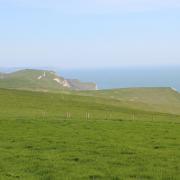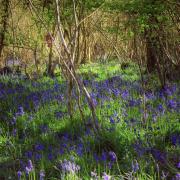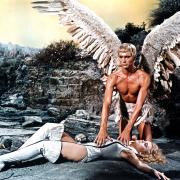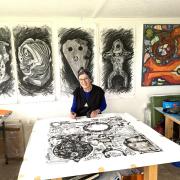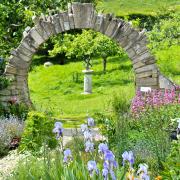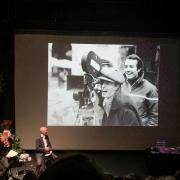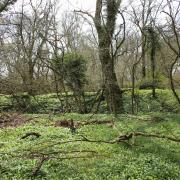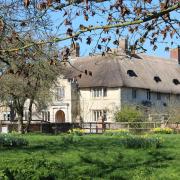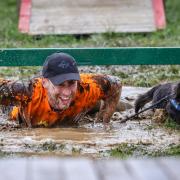From Cybermen to Daleks, over the last 50 years Doctor Who has battled with a seemingly endless parade of alien adversaries and some of those encounters have been in Dorset. We entered the domain of a would-be Time Lord in Poole to find out more.
Scott Fellowes is showing me his favourite sonic screwdriver. He takes aim and fires at his desk. There’s a burst of flashing lights and buzzing sounds and I’ll swear that, just for a moment, this 41-year-old Dorset college administrator actually turns into Doctor Who.
OK a moment ago he was wearing a kind of frock coat, long striped scarf and a button bearing the Gallifreyan symbol of the Time Lords, the mystical Seal of Rassilon. And he’s not exactly short of sonic screwdrivers either - he has a huge collection. Even more impressively, this spare room in his otherwise perfectly normal Poole flat is packed with Doctor Who memorabilia. Books, posters, magazines and DVDs line the walls. There are model Daleks galore and more Tardi (assuming that is the plural of Tardis) than you could shake a sink plunger at. There’s even a Time Lord passport and countless other related nick-nacks.
In this 50th anniversary year of Doctor Who - the first episode was broadcast on Saturday 23rd November 1963 - Scott’s extraordinary collection seems to be coming into its own. “It’s great time to be a geek,” he tells me. “We are having our moment in the sun.” His collection - almost 30 years in the making - also adds to a growing number of Doctor Who connections boasted by the county..
Wareham Quarry and various local sandpits were favoured locations for alien landscapes in several early episodes. The 1983 adventure The Awakening, starring Peter Davison was filmed at Shapwick and Tarrant Monkton. Lulworth Cove provided the backdrop for 1989’s The Curse of Fenric and the old Warmwell Quarry was the location for The Survivor filmed the same year. In 2008 Dorset actor Julian Bleach memorably played the Doctor’s deadliest foe the hideously disfigured mad scientist Davros. Meanwhile any self-respecting Doctor Who fan will tell you that Bournemouth University has a full-size Tardis in the foyer of its School of Media Studies. The 1960s police box time-machine is a nod to the personal and professional interests of the department’s Associate Dean for Media Production, Dr Andrew Ireland whose doctorate - Conditions of Time and Space - was actually based on Doctor Who. Even the Sandworld sand-sculpture park at Weymouth has had the Doctor and the Daleks as part of its summer display this year.
Scott himself says his first memory of Doctor Who involved watching Tom Baker trying to save the world from annihilation in the 1970s adventure The Seeds of Doom as a deadly mutant pod lumbered across lawns of Athelhampton House near Dorchester.
“I think at the time I thought it was a giant green octopus,” he recalls. ”Whatever it was it was quite terrifying.” His imagination piqued, he quickly locates the DVD to check out the picture on the cover. Sure enough there is an image of alien vegetation looking decidedly giant squid-like as it zaps the grounds of the 15th century mansion.
Everything relating to Doctor Who is at Scott’s fingertips in this room. He calls it his study. His wife Ana calls it his playroom. “She’s right of course,” he sighs. “This is a boys’ playroom. I don’t much like doing grown-up stuff. The thing is that Ana’s a minimalist, she doesn’t like clutter. I’m like an old professor. I like studies with lots of books and papers. I just love stuff!”
They might not sound like the perfectly matched couple. Indeed, on hearing of Scott’s plan to spend the afternoon talking about Doctor Who, Ana has decided to go out. It is clear however that they have reached a very amicable understanding.
“We met at a Star Trek group,” says Scott. “She thought I was a complete geek and I thought she was a bossy little cow.” Somehow it worked. The couple will celebrate 20 years together next year.
Scott jealously protects his Doctor Who collection. “I get quite uncomfortable when other people come in here,” he admits. He visibly winces at the memory of his six-year-old nephew finding a set of Lego Daleks. “He de-masted three of them - I was quite distraught. Ana simply said: ‘Well they’re not much threat to the universe now are they?’”
When he’s not doing his day job as an administrator at Bournemouth and Poole College, Scott works at media events for MCM Comic Con – huge conferences that promote cult TV, comics and games. Upwards of 60,000 people attend these massive events held in London, Birmingham, Manchester and Glasgow and Doctor Who is a big attraction. Despite his geeky credentials Scott is wary of tabloid stereotyping. “We’ve done a lot of events and journalists always tend to focus on the one spod in a Def Leppard T-shirt with a plaster on his glasses. I know there are sad losers out there who live with their mum in a basement with a laminated poster of Wonder Woman on the wall. I just hope I’m proving I’m more of a human being.”
Over the past half-a-century eleven actors - William Hartnell, Patrick Troughton, Jon Pertwee, Tom Baker, Peter Davison, Colin Baker, Sylvester McCoy, Paul McGann, Christopher Eccleston, David Tennant and Matt Smith - have played the Doctor. With the announcement in June that Matt Smith would be leaving the role there were weeks of wild speculation about who would appear when the character regenerated in the forthcoming Christmas special. Hopes for a more daring choice of doctor were dashed with the announcement that it would be Peter Capaldi - male, white and best known as foul-mouthed political spin-doctor Malcom Tucker from the The Thick of It. Capaldi was hotly tipped for the role and a highly popular choice. It came as little surprise to Scott Fellowes who had already told me that, knowing the conservative tastes of the fan-base, a white British male actor would almost certainly step into the role.
Even though one or two dissenters argued that, at 55, Capaldi is too old for the job, Scott heartily approves of his appointment. “I think it is good casting,” he says, though I detected just the tiniest note of regret in his response. On display in his room is a splendid self-drawn illustration showing the Doctors standing in sequence from Hartnell to Smith plus, coming in at number 12, Scott himself. “Well it would have been great, wouldn’t it?” he sighs. Scott harbours one other Doctor Who related desire. He’d love to own a life-size Tardis, just like the one at Bournemouth University. “I keep thinking of making one,” he tells me. “I’ve got the plans from the Tardis Builders Guild and everything, but I’m afraid Ana says no.”
Doctor Who on location in Dorset
Wareham Quarry and various local sandpits were frequently used as alien landscapes in several early episodes of Doctor Who including:
Death to the Daleks (1974) featuring Jon Pertwee as the Doctor. The sand pit at Puddletown Road, Gallows Hill became the alien planet Exillon. Today it is the Dorset Wildlife Trust reserve known as Higher Hyde Heath.
The Seeds of Doom (1975) features Tom Baker doing battle with the Krynoid in the grounds of Athelhampton House near Dorchester.
Destiny of the Daleks (1979) featuring Tom Baker was filmed at Binnegar Heath Sand Pit near Wareham and also Winspit Quarry at Worth Matravers.
The Awakening (1983) featuring Peter Davison as the Doctor was filmed in the villages of Shapwick and Tarrant Monkton. Davison’s final episode as the Doctor - The Caves of Androzani - was filmed at a sand pit near Wareham.
The Greatest Show in the Galaxy (1988) featuring Sylvester McCoy was filmed at a private quarry in Warmwell. The following year Lulworth Cove was the backdrop for The Curse of Fenric (1989) and then McCoy returned to Warmwell Quarry for an episode called The Survivor the final story from Doctor Who’s original run.
For more information and pictures of Doctor Who in Dorset go to bbc.co.uk/dorset/content/image_galleries/doctor_who_dorset_gallery.shtml




